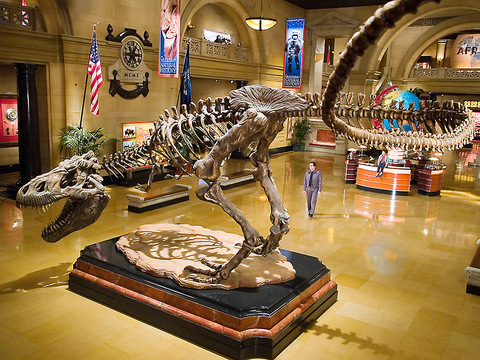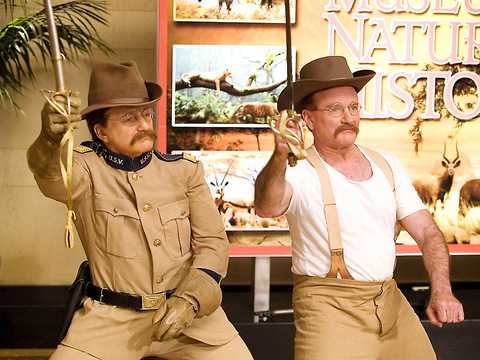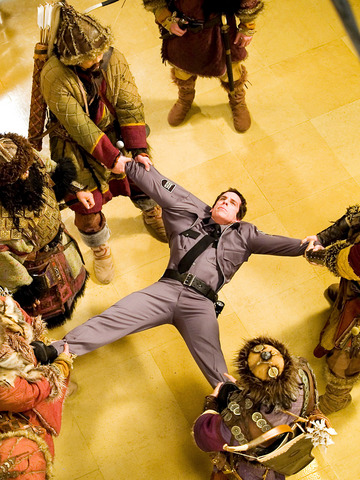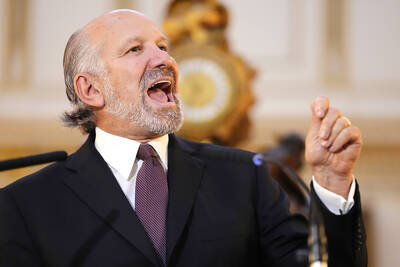IN Night at the Museum, gigantism rules. This season's answer to Dr. Seuss' How the Grinch Stole Christmas, it's an overstuffed grab bag in which lumps of coal are glued together with melted candy.
Yes, the bag does hold some clever robotic toys, but many are broken. If you were to line up the niftiest thingamajigs created for this tale of a would-be inventor-turned-night-watchman, you might have something resembling Jumanji Meets The Wizard of Oz with a dash of Home Alone. But the fable arrives smothered in an uneasy blend of wisecracks and pallid inspirational blather.
A self-described action-adventure comedy, Night at the Museum is exactly that: It wants to be all things to all people under a certain age. Shawn Levy (the Cheaper by the Dozen movies, the Pink Panther remake), who directed from Robert Ben Garant and Thomas Lennon's adaptation of a book by Milan Trenc, subscribes enthusiastically to the current Hollywood philosophy that coherence doesn't matter if enough stuff is thrown onto the screen. Contributing to the bulk is a score (by Alan Silvestri) that rivals the Star Wars soundtracks in pounding grandiosity.

PHOTOS COURTESY OF FOX
It's fair to say that Night at the Museum is better than the insufferable Jim Carrey Grinch, a landmark of holiday film excess. It knows how to build excitement by steadily accelerating the pace and widening the spectacle. Almost in spite of itself, it sets off occasional little bursts of cinematic magic.
The movie begins as a droopy family comedy about the divorced, unemployed Larry Daley (Ben Stiller, ably going through the motions), who is so down and out he may have to move from Manhattan to (gasp!) Queens. It quickly builds to a CGI (computer generated imagery) extravaganza in the halls of the American Museum of Natural History in New York. There (where the movie wasn't actually filmed, except for exteriors), its hapless protagonist takes a job as the museum's night watchman.
Larry, oblivious to the strange looks on the faces of the three guards he's replacing — Cecil (Dick Van Dyke), Gus (Mickey Rooney) and Reginald (Bill Cobbs) — has no idea what's awaiting him. No sooner have they departed, handing him the keys with strict instructions that nothing leave the museum, than the place stirs to life. In no time Larry is playing frightened ringmaster to a rampaging circus of exhibits that have come to life through the magic of a priceless Egyptian tablet.

A Tyrannosaurus rex hops off its pedestal and like a famished zombie begins clumping after Larry, who discovers that if he throws it a bone, it fetches like a dog. Cute. A stone head from Easter Island demands bubble gum. And a cheeky monkey named Dexter steals Larry's keys, tears up his instructions and engages him in a face-slapping routine.
At first it seems as though the menacing wild animals (both prehistoric and contemporary) will be Larry's nemeses. But Night at the Museum squeezes the most juice from its historical figures, some life-sized, others miniature, some in dioramas and others on pedestals. The most amusing image is of Stiller, wide-eyed and floppy-eared, besieged by bands of tiny, finger-sized warriors furiously hurling spears and darts at him.
Of the historical figures, Robin Williams' Teddy Roosevelt is the noisiest. Once this statue steps off his equestrian roost, he behaves like a bossy, slogan-dispensing drill instructor, whipping Larry into moral shape. But beneath his bluster, the facsimile of the 26th president is an emotional basket case, who admits in a weak moment that he is a synthetic product manufactured in Poughkeepsie. For most of the film, he pines silently after Sacajawea (Mizuo Peck), the famous Indian tracker locked inside the glass case of a Lewis and Clark diorama.

Profitable screen time is devoted to the continuing territorial squabble between tiny figurines of Octavius (Steve Coogan), the Roman general, and Jedediah (Owen Wilson, uncredited), a rootin'-tootin' American cowboy. Bizarrely, the movie gives their dispute a gay subtext. In a slip of the tongue, Octavius addresses Larry as Mary, and Jedediah, quoting from Brokeback Mountain, tells Octavius, "I can't quit you." I guess it means that nowadays such smidgens of South Park humor are thrown into family movies to make everybody feel terribly knowing.
But when Night at the Museum returns to Larry's personal life, it dies. The movie doesn't even make a pretense of being interested in the scenes between Larry and Nick (Jake Cherry), the 10-year-old son whose respect he is losing. And its cynical lack of concern for giving the characters human feelings is a grave drawback for a movie that wants to engage children.

In recent weeks the Trump Administration has been demanding that Taiwan transfer half of its chip manufacturing to the US. In an interview with NewsNation, US Secretary of Commerce Howard Lutnick said that the US would need 50 percent of domestic chip production to protect Taiwan. He stated, discussing Taiwan’s chip production: “My argument to them was, well, if you have 95 percent, how am I gonna get it to protect you? You’re going to put it on a plane? You’re going to put it on a boat?” The stench of the Trump Administration’s mafia-style notions of “protection” was strong

Every now and then, it’s nice to just point somewhere on a map and head out with no plan. In Taiwan, where convenience reigns, food options are plentiful and people are generally friendly and helpful, this type of trip is that much easier to pull off. One day last November, a spur-of-the-moment day hike in the hills of Chiayi County turned into a surprisingly memorable experience that impressed on me once again how fortunate we all are to call this island home. The scenery I walked through that day — a mix of forest and farms reaching up into the clouds

With one week left until election day, the drama is high in the race for the Chinese Nationalist Party (KMT) chair. The race is still potentially wide open between the three frontrunners. The most accurate poll is done by Apollo Survey & Research Co (艾普羅民調公司), which was conducted a week and a half ago with two-thirds of the respondents party members, who are the only ones eligible to vote. For details on the candidates, check the Oct. 4 edition of this column, “A look at the KMT chair candidates” on page 12. The popular frontrunner was 56-year-old Cheng Li-wun (鄭麗文)

“How China Threatens to Force Taiwan Into a Total Blackout” screamed a Wall Street Journal (WSJ) headline last week, yet another of the endless clickbait examples of the energy threat via blockade that doesn’t exist. Since the headline is recycled, I will recycle the rebuttal: once industrial power demand collapses (there’s a blockade so trade is gone, remember?) “a handful of shops and factories could run for months on coal and renewables, as Ko Yun-ling (柯昀伶) and Chao Chia-wei (趙家緯) pointed out in a piece at Taiwan Insight earlier this year.” Sadly, the existence of these facts will not stop the